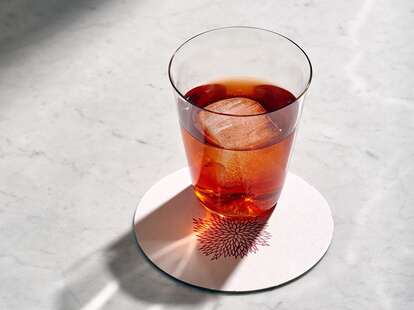
Photo courtesy of Forthhave Spirits
For the better part of 15 years, amaro has been trending among American bartenders. It started with the rise in popularity of what is now the default “bartender handshake,” a shot of Fernet-Branca. This was soon followed by waves of Negronis and Aperol Spritzes on drink menus at bars and restaurants that focus on craft, regardless of whether the food program was overtly Italian or Mediterranean. By the mid-2010s, every bar worth its salt could serve a solid Negroni.
As amaro culture continues to evolve in bars and industry circles, a new trend has emerged. American-made amaro is the latest way creative distillers and bartenders are incorporating traditional flavors and techniques into profoundly local liquids.

Cocktail Culture
One of the bars that played a critical role in driving American amaro trends was New York City’s PDT. On its menu and in its eponymous cocktail book, published in 2009, PDT featured such variations as Katie Stipe’s Siesta, a tequila iteration, and the Berlioni, a slightly off kilter Negroni made with Cynar. Meanwhile, Dante, the Manhattan cocktail bar that opened in 2015, put the Negroni and Italian aperitivo firmly front and center on the global bar stage, and garnered numerous accolades in the process.
As PDT’s influence and ethos started to spread, amaros began to move from the dustiest corners of the back bar to make their way into glasses. Old Fashioned and Manhattan riffs were among the first to receive the amaro treatment: The Redhook, Newark, and similarly themed drinks begin to show up on menus in Brooklyn haunts such as Clover Club and now-shuttered Prime Meats.
In 2011, Sother Teague opened Amor y Amargo, the first amaro-themed bar in New York City. It remains a mainstay for industry and consumers to sample and compare the best and newest products in the category. Similarly themed programs, such as Billy Sunday in Chicago and Republique in Los Angeles soon followed, and continue to be bastions for the category, stocking large amaro selections and creating appealing cocktails with them.
Several books on amaro and bitters have been published in the past decade, too, and, in many cities, a wide array of bars run Negroni Week menus and happy hours.

American Amaro
As these developments gathered steam, so did another, simultaneous trend. Across the country, bars, distilleries, and breweries opened to meet a growing demand for locally made products like beer, wine, cider, and every spirit category under the sun. Soon, American amaro began to show up on the scene as well.
In 2018, Highwire Distilling, based in Charleston, SC, released its first version, a soft, medium-bodied expression featuring tea and mint. Shortly thereafter, J. Rieger Co. released a coffee-inspired amaro that anticipated the craze for coffee liqueurs and Espresso Martinis that we’re in the middle of right now.
Lo-Fi Aperitifs, a brand that launched in San Francisco in 2015, uses a range of local and traditional ingredients in its products that are specifically targeted at bartenders.
“Hibiscus may be the most important ingredient for us,” says Victoria Canty, Lo-Fi’s LA-based ambassador. “It not only imparts a floral and tart flavor profile, but it gives us our naturally pink iconic color, something truly unique to Lo-Fi. It was also created with bartenders and cocktails in mind.”

Back in NYC, producers such as St. Argestisis and Forthave put out expressions that skewed more on the bitter end of the spectrum. Forthave founders Aaron Fox and Daniel de La Nuezare say their inspiration came from their initial encounter with Varnelli Amaro Dell Érborista at a dinner in Brooklyn six years ago. “Part of the impetus of the brand was to be able to create a product that could address questions around transparency in regards to ingredients—in our case, as we are based in Brooklyn, this meant incorporating products from the Hudson Valley,” Fox says.
Since then, Forthave has released numerous expressions that draw inspiration from the local landscape. Walnuts harvested from the Hudson Valley make their amaro a popular choice in a Black Manhattan, while their bitter expression has made its way into various Negronis in a range of bar programs throughout New York City.
Amaros’ diversity in cocktails and as standalone spirits “really leaves the door open for so many new ideas and iterations within the category,” Maybee says. “The possibilities could truly be endless.”